India Celebrates
100 Years Of Aviation
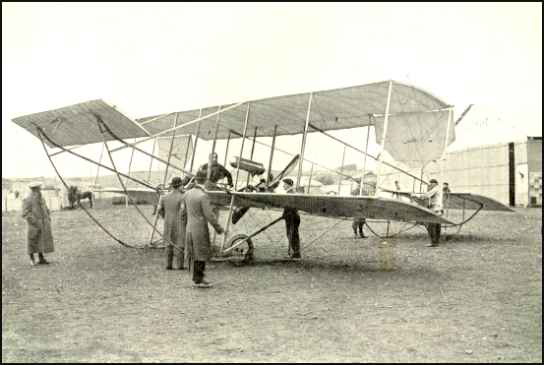
A Roger Sommer Biplane
|
Although the weather is uncharacteristically
cold this week in New Delhi, plans are heating up to celebrate a century
of aviation, as Indian Civil Aviation will complete its first 100 years
on February 18, 2011.
The year 2011-12 has now been declared as
the India Civil Aviation Centenary Year.
The story of February 18, 1911 is one of
high adventure and aviation pioneering that set a global record, an air
cargo first.
Despite some claims to the contrary, the
first airplane (heavier than air) in the world to carry a payload other
than a passenger (express cargo) moved above India, not Ohio, USA.
As the story goes, a Wright-built airplane
piloted by Philip O. Parmelee carried a bolt of silk cloth from Dayton
to Columbus, Ohio on November 7, 1911.
The fact is that Henri Pequet, a 23-year
old French pilot (he lived until 1974), carried more than 6,000 letters
between Allahabad.
The point here is that we need to get this
history correct, because in 2011 all kinds of claims will come forward
as companies and nations ramp up stories of their first flights and the
role they played during this important Centennial Year in global aviation.
In early December 1910, the SS Persia arrived
in Bombay with big cases containing plane parts.
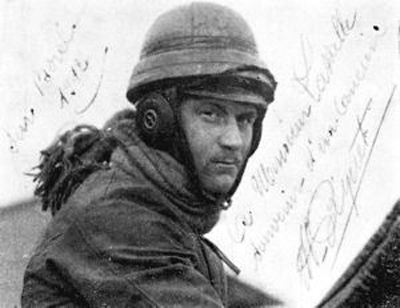 Accompanying
the cargo were Commander Sir Walter George Windham and two pilots—Henri
Pequet, (left) a Frenchman, and Keith Davies, an Englishman. Accompanying
the cargo were Commander Sir Walter George Windham and two pilots—Henri
Pequet, (left) a Frenchman, and Keith Davies, an Englishman.
Two mechanics went along with them: Haffkin
(English) and Billon (French).
This was the team sent by Humber Motor Company
in Coventry, England to exhibit the planes at the Industrial and Agricultural
Exhibition, held at Allahabad UP (United Provinces).
In 1910 the Humber Motor Company started
manufacturing monoplanes, called Humber Bleriot, under license Bleriot
XI.
Toward the end of the year, they manufactured
two Roger Sommer biplanes, one of which was sent to India with the team.
The Roger Sommer biplane
was basically a modified Henri Farman biplane with a 50 HP, seven cylinder
air-cooled Gnome rotary engine.
The party arrived in Allahabad, where two
planes were assembled.
Sir Windham was approached by the clergyman
in charge of Holy Trinity Church, Allahabad, to see if he could raise
some funds for a hostel planned by the church.
Windham thought that if he could fly some
mail across the river Ganges (Ganga) to Naini and put a special postmark,
he could raise the money for the hostel.
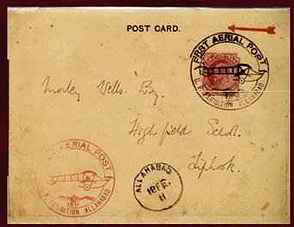 The
Postmaster General of United Provinces and the Director General of Post
Office in India approved the idea and a special postmark was authorized.
The cancellation read “First Aerial Post.” A clergyman was
appointed as the Postmaster at the parade ground at Naini. The
Postmaster General of United Provinces and the Director General of Post
Office in India approved the idea and a special postmark was authorized.
The cancellation read “First Aerial Post.” A clergyman was
appointed as the Postmaster at the parade ground at Naini.
A surcharge of 6 annas (37 paise today)
was made and letters poured in from all over India.
One letter had stamps worth 25 rupees. On
February 17th, the day before the event, the Oxford and Cambridge Hostel
at Allahabad was turned into a small GPO.
The sorting of letters and postcards (approximately
6,000) started at 9.00 hours in the morning and lasted till midnight.
Henri Pequet signed some 400 postcards himself!
It was a fine morning at Allahabad on the
18th of February 1911.
Henri Pequet took off with a wristwatch
on his right hand and an altimeter fixed to his left knee.
The biplane flew to Naini at 40 mph at an
altitude of 130 feet.
He landed at Naini, 8 km from Allahabad,
to be greeted by the lone postmaster.
Pequet flew back alone.
The whole journey lasted 27 minutes.
The occasion coincided with Purna Kumbha,
the Hindu festival held once every 12 years.
Pequet had a bird’s eye view of a
million Indians washing away their sins in the Ganges below.
Thus the event was watched by over a million
Indians that day!
One of the recipients of the first airmail
was King George V of England.
His secretary wrote to Windham:
"The King desires me to send you his
thanks for the letter he received from India, bearing the inscription
‘First Aerial Post,’ which will be an interesting addition
to His Majesty's stamp collection."
By the way, the mail was offloaded on a
train and taken to Calcutta.
Commercial operations, connecting the national
capital in New Delhi to Karachi via Jodhpur and beyond, began on December
20, 1929 and were operated by Imperial Airways.
Fast forward to 2011. For the next year
running up to 2012, there will be special events and celebrations to mark
the Centenary Year to be organized by a high level committee constituted
by the India’s Civil Aviation Ministry.
“The committee will deliberate upon
the period of celebrations, formulate an action plan for the entire year
and decide events which may be undertaken during the centenary years,”
CAM said in a statement.
During the year, activities like air shows,
establishment of an air and space theme park/museum and an aviation university
have been planned.
The committee includes the current (Praful
Patel), former Civil Aviation Ministers and eminent Indians who have contributed
to the country’s civil aviation sector.
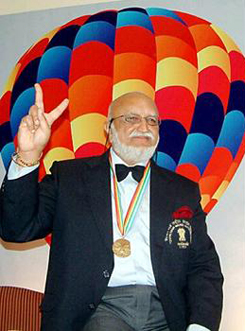
Vijaypath Singhania
|
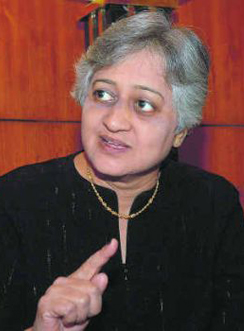
Saudamini Deshmukh
|
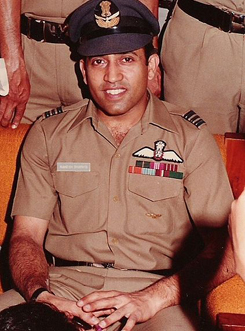
Rakesh Sharma
|
Among them are the first
Indian Cosmonaut, Rakesh Sharma; industrialist (and balloonist) Vijaypath
Singhania; Air Marshal Arjan Singh; Saudamini Deshmukh; the first lady
pilot in the commander’s seat in India, Satish Sharma; Member of
Parliament and Chairman of the Aero Club of India, Capt. G. R. Gopinath;
Secretaries of the Ministries of Civil Aviation, Defense and Tourism and
Chairpersons of all Indian airlines and airports, along with other stakeholders.
For the record, since 1911 aviation in India
has taken giant strides and today is the ninth largest civil aviation
market in the world.
Some civil aviation pundits believe that
the country will emerge as one of the three largest markets in the world
by 2020.
TG/Geoffrey
Special Thanks to the Dakshina Kannada Philatelic Association. |




 Accompanying
the cargo were Commander Sir Walter George Windham and two pilots—Henri
Pequet, (left) a Frenchman, and Keith Davies, an Englishman.
Accompanying
the cargo were Commander Sir Walter George Windham and two pilots—Henri
Pequet, (left) a Frenchman, and Keith Davies, an Englishman. The
Postmaster General of United Provinces and the Director General of Post
Office in India approved the idea and a special postmark was authorized.
The cancellation read “First Aerial Post.” A clergyman was
appointed as the Postmaster at the parade ground at Naini.
The
Postmaster General of United Provinces and the Director General of Post
Office in India approved the idea and a special postmark was authorized.
The cancellation read “First Aerial Post.” A clergyman was
appointed as the Postmaster at the parade ground at Naini. 